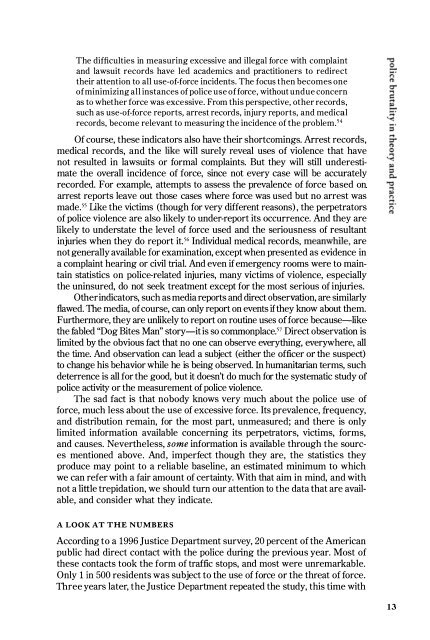Kristian Williams - Our Enemies in Blue - Police and Power in America
Kristian Williams - Our Enemies in Blue - Police and Power in America
Kristian Williams - Our Enemies in Blue - Police and Power in America
You also want an ePaper? Increase the reach of your titles
YUMPU automatically turns print PDFs into web optimized ePapers that Google loves.
The difficulties <strong>in</strong> measur<strong>in</strong>g excessive <strong>and</strong> illegal force with compla<strong>in</strong>t<strong>and</strong> lawsuit records have led academics <strong>and</strong> practitioners to redirecttheir attention to all use-of-force <strong>in</strong>cidents. The focus then becomes oneof m<strong>in</strong>imiz<strong>in</strong>g all <strong>in</strong>stances of police use of force, without undue concernas to whether force was excessive. From this perspective, other records,such as use-of-force reports, arrest records, <strong>in</strong>jury reports, <strong>and</strong> medicalrecords, become relevant to measur<strong>in</strong>g the <strong>in</strong>cidence of the problem.54Of course, these <strong>in</strong>dicators also have their shortcom<strong>in</strong>gs. Arrest records,medical records, <strong>and</strong> the like will surely reveal uses of violence that havenot resulted <strong>in</strong> lawsuits or formal compla<strong>in</strong>ts. But they will still underestimatethe overall <strong>in</strong>cidence of force, s<strong>in</strong>ce not every case will be accuratelyrecorded. For example, attempts to assess the prevalence of force based onarrest reports leave out those cases where force was used but no arrest wasmade. ,5 Uke the victims (though for very different reasons) , the perpetratorsof police violence are also likely to under-report its occurrence. And they arelikely to understate the level of force used <strong>and</strong> the seriousness of resultant<strong>in</strong>juries when they do report it.56 Individual medical records, meanwhile, arenot generally available for exam<strong>in</strong>ation, except when presented as evidence <strong>in</strong>a compla<strong>in</strong>t hear<strong>in</strong>g or civil trial. And even if emergency rooms were to ma<strong>in</strong>ta<strong>in</strong>statistics on police-related <strong>in</strong>juries, many victims of violence, especiallythe un<strong>in</strong>sured, do not seek treatment except for the most serious of <strong>in</strong>juries.Other <strong>in</strong>dicators, such as media reports <strong>and</strong> direct observation, are similarly:flawed. The media, of course, can only report on events if they know about them.Furthermore, they are unlikely to report on rout<strong>in</strong>e uses of force because-likethe fabled "Dog Bites Man" story-it is so commonplace. 57 Direct observation islimited by the obvious fact that no one can observe everyth<strong>in</strong>g, everywhere, allthe time. And observation can lead a subject (either the officer or the suspect)to change his behavior while he is be<strong>in</strong>g observed. In humanitarian terms, suchdeterrence is all for the good, but it doesn't do much for the systematic study ofpolice activity or the measurement of police violence.1ne sad fact is that nobody knows very much about the police use offorce, much less about the use of excessive force. Its prevalence, frequency,<strong>and</strong> distribution rema<strong>in</strong>, for the most part, unmeasured; <strong>and</strong> there is onlylimited <strong>in</strong>formation available concern<strong>in</strong>g its perpetrators, victims, forms,<strong>and</strong> causes. Nevertheless, some <strong>in</strong>formation is available through the sourcesmentioned above. And, imperfect though they are, the statistics theyproduce may po<strong>in</strong>t to a reliable basel<strong>in</strong>e, an estimated m<strong>in</strong>imum to whichwe can refer with a fair amount of certa<strong>in</strong>ty. With that aim <strong>in</strong> m<strong>in</strong>d, <strong>and</strong> withnot a little trepidation, we should turn our attention to the data that are available,<strong>and</strong> consider what they <strong>in</strong>dicate.A LOOK AT THE NUMBERSAccord<strong>in</strong>g to a 1996 Justice Department survey, 20 percent of the <strong>America</strong>npublic had direct contact with the police dur<strong>in</strong>g the previous year. Most ofthese contacts took the form of traffic stops, <strong>and</strong> most were unremarkable.Only 1 <strong>in</strong> 500 residents was subject to the use of force or the threat of force.Three years later, the Justice Department repeated the study, this time with13


